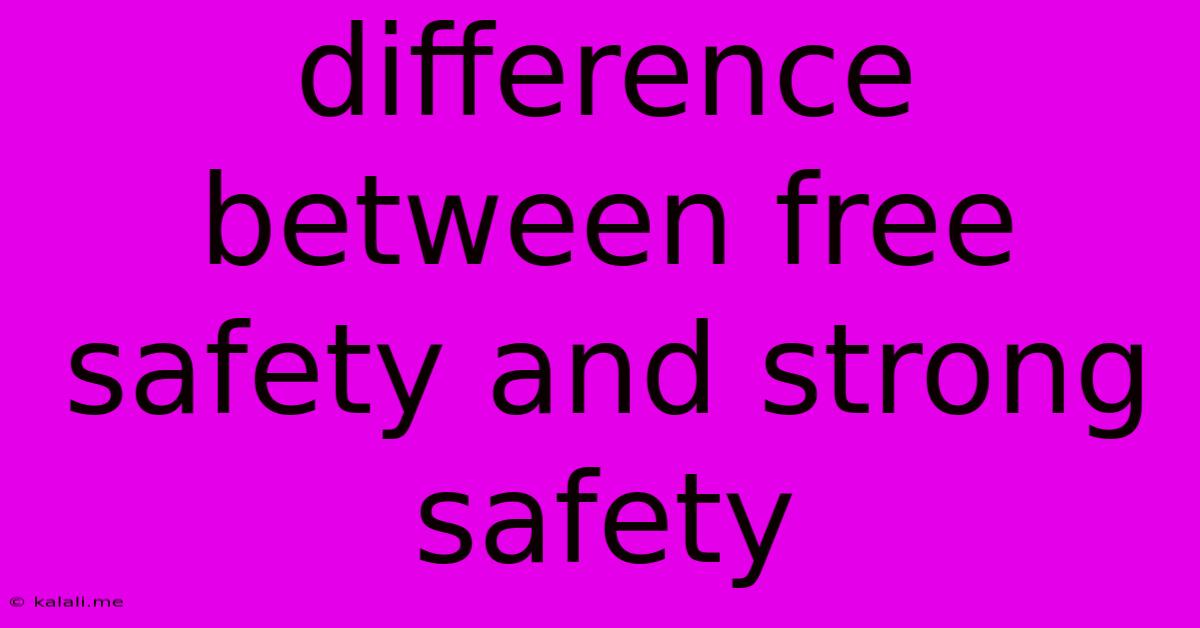Difference Between Free Safety And Strong Safety
Kalali
Jun 11, 2025 · 4 min read

Table of Contents
Decoding the Difference: Free Safety vs. Strong Safety in Football
The safety position in football, often overlooked in casual conversation, plays a crucial role in a team's defensive strategy. Understanding the nuances of the two main safety types – the free safety and the strong safety – is key to appreciating their distinct contributions. This article will delve into the key differences in their responsibilities, alignments, and skill sets, highlighting what sets each apart.
What is a Safety?
Before diving into the specifics, let's establish a common understanding. Safeties are the last line of defense, responsible for protecting the deep part of the field against long passes and run plays that break through the initial defensive line and linebackers. They are versatile athletes who need to combine speed, agility, tackling ability, and strong instincts.
The Free Safety (FS): The Centerfielder of the Defense
The free safety, often referred to as the "center fielder" of the defense, typically aligns deeper than the strong safety. His primary responsibility is to read the offense's formation and react to the developing play. Think of him as the quarterback of the secondary, making crucial decisions based on the opponent's actions.
Key Responsibilities of a Free Safety:
- Deep coverage: The FS is responsible for covering the deep middle of the field, preventing long bombs and deep passes. They need excellent range, speed, and the ability to judge the flight of the ball.
- Run support: While primarily focused on pass defense, the free safety will assist in run support, particularly when the run breaks outside the tackles or when there's a broken play.
- Blitzing: Although not their primary role, skilled free safeties can be effective blitzers, surprising quarterbacks and disrupting plays before they even develop.
- Pre-snap reads: The FS is often tasked with reading the offense's formation and tendencies before the snap, helping dictate the defensive play call. This requires exceptional game awareness.
Skill Set of a Successful Free Safety:
- Exceptional speed and agility: Crucial for covering vast amounts of ground.
- Ball-hawking skills: Interceptions and pass break-ups are a hallmark of a successful free safety.
- Excellent instincts and anticipation: Ability to read the quarterback's eyes and anticipate the receiver's route.
- Strong tackling ability: Important for run support and when making plays on receivers after the catch.
The Strong Safety (SS): The Hybrid Defender
The strong safety, in contrast to the free safety, usually lines up closer to the line of scrimmage. Their responsibilities are more varied and often involve a mix of run defense and pass coverage. They act as a hybrid, blending the responsibilities of a linebacker and a safety.
Key Responsibilities of a Strong Safety:
- Run support: The SS is often the first line of defense against run plays to their side of the field. They are expected to be strong tacklers and aggressively pursue ball carriers.
- Coverage near the line: The SS will often cover tight ends and running backs in short-to-intermediate routes.
- Blitzing: Their proximity to the line makes them effective blitzers, often rushing the quarterback from unexpected angles.
- Assisting with coverage: They support the cornerback or other safeties on pass plays, particularly on short and intermediate routes.
Skill Set of a Successful Strong Safety:
- Excellent tackling technique: Essential for stopping run plays near the line.
- Good coverage skills: Ability to cover tight ends and running backs, even if not as extensive as a cornerback.
- Physicality and aggression: Needed for run support and blitzing.
- Strong understanding of defensive schemes: The strong safety needs to understand the team’s overall strategy and how his role fits within it.
Summary Table: Free Safety vs. Strong Safety
| Feature | Free Safety (FS) | Strong Safety (SS) |
|---|---|---|
| Alignment | Deeper in the secondary | Closer to the line of scrimmage |
| Primary Role | Deep coverage, preventing long passes | Run support, short-to-intermediate coverage |
| Key Skills | Speed, agility, ball-hawking, instincts | Tackling, physicality, coverage versatility |
| Style | Reactive, reads and reacts | Proactive, more involved in run defense |
Ultimately, both free safeties and strong safeties are vital components of a successful defense. Their distinct roles and skill sets make them complementary players, contributing to a well-rounded and effective secondary. Understanding these differences is crucial for any serious football fan or aspiring coach.
Latest Posts
Latest Posts
-
Leader Who Wrote The Discovery Of India
Jun 12, 2025
-
The Land Of The Morning Calm
Jun 12, 2025
-
What Is 50 Of 50 Of 50
Jun 12, 2025
-
Which Of The Following Is An Example Of Intrinsic Motivation
Jun 12, 2025
-
Any Substance That Occupies Space And Has Weight Is
Jun 12, 2025
Related Post
Thank you for visiting our website which covers about Difference Between Free Safety And Strong Safety . We hope the information provided has been useful to you. Feel free to contact us if you have any questions or need further assistance. See you next time and don't miss to bookmark.